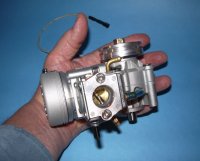Propeller lift
dodol created the topic: Propeller lift
I know octura X series is low lift prop, and some others is high lift
the question is which part of prop make lift?
and can we change lifting prop to low lift or vice versa?
the question is which part of prop make lift?
and can we change lifting prop to low lift or vice versa?
Please Log in or Create an account to join the conversation.
- dodol
- Offline
- Posts: 31
- Thank you received: 1
Hot Rods replied the topic: Propeller lift
A lot of factors play into prop lift. An exaggerated tongue ( lead area of the blade close to the hub ) can lift the transom as it "slaps" into the water. A relatively flat blade profile from hub to outer edge can "spill" water off the side of the blade, and force it up ( in the air ) and down ( in the water ). Whatever the rooster tail is doing above, the water is doing the same below, in this case causing the transom to lift. A shallow rake angle ( trailing edge of blade to the hub ) can also cause water to be pushed up rather than back. Star tip ( cleaver props ) are usually considered lifting, while choppers ( rounded tips ) tend to be less lifting. But like most things there are no hard and fast rules, as they can both be one or the other.
In most cases a lifting prop can be bent/cut to eliminate some lift, but it's harder to go the other way.
In most cases a lifting prop can be bent/cut to eliminate some lift, but it's harder to go the other way.
Please Log in or Create an account to join the conversation.
- Hot Rods
-

- Offline
- Posts: 164
- Karma: -5
- Thank you received: 36
randyrap replied the topic: Re:Propeller lift
Cupping will reduce lift.
IMPBA # 14315 CD
Northern Lights Model Boat Club
www.nlmbc.org
Please Log in or Create an account to join the conversation.
- randyrap
-

- Offline
Time to create page: 0.085 seconds
